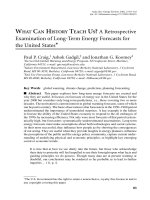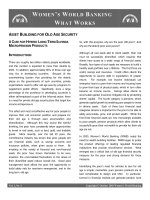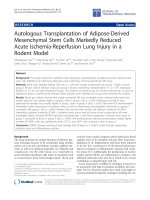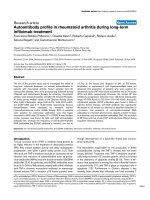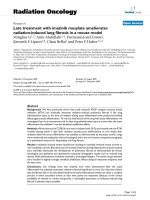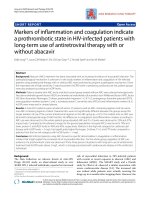Reversible lung fibrosis in a 6-year-old girl after long term nitrofurantoin treatment
Bạn đang xem bản rút gọn của tài liệu. Xem và tải ngay bản đầy đủ của tài liệu tại đây (823.46 KB, 4 trang )
(2020) 20:313
Mikkelsen and Rubak BMC Pulm Med
/>
Open Access
CASE REPORT
Reversible lung fibrosis in a 6‑year‑old girl
after long term nitrofurantoin treatment
Lise Fischer Mikkelsen* and Sune Rubak
Abstract
Background: Pulmonary side effects are well known, including lung fibrosis, in elderly patients treated with longterm nitrofurantoin to prevent urinary tract infections and secondary renal injury. However, pulmonary side effects
have only been reported rarely in paediatric cases, despite nitrofurantoin being a first line prophylactic treatment of
recurrent childhood urinary tract infection.
Case presentations: A 6-year-old girl was admitted to the hospital with dyspnea, general fatigue, loss of appetite
and need for nasal oxygen treatment after long-term nitrofurantoin treatment. A computed tomography scan of the
chest showed lung fibrosis. A biopsy confirmed this diagnosis. We suspected the fibrosis to be caused by the nitrofurantoin treatment. Thorough examinations reveal no other explanations. Nitrofurantoin was discontinued and the
girl was treated with methylprednisolone. After 17 month a new scan and lung function test showed total regression
of the lung fibrosis.
Conclusions: This case underlines that risk of severe side effects should be taken in to account before initiation of
long-term nitrofurantoin treatment in children.
Keywords: Nitrofurantoin, Side effects, Urinary tract infection, Lung fibrosis, Paediatrics
Background
Nitrofurantoin has been a first line antibiotic choice in
prophylactic treatment of childhood urinary tract infection. Pulmonary toxicity causing irreversible pulmonary
fibrosis is a well-known side effect of long-term nitrofurantoin treatment and other biological treatments in
adults and elderly [1-4]. However, only few cases have
been reported of pulmonary affection in children after
nitrofurantoin treatment [5, 6].
We report a case of a 6-year-old girl who developed
dyspnea and interim need for nasal oxygen treatment due
to pulmonary fibrosis manifesting after 2 years of nitrofurantoin treatment.
*Correspondence:
Department of Paediatrics and Adolescent Medicine, Danish Center
of Paediatric Pulmonology and Allergology, Aarhus University Hospital,
Aarhus N, Denmark
Case presentation
The 6-year-old girl was admitted to the hospital with
dyspnea, general fatigue and loss of appetite developing
during approximately 1 month. At admission, oxygen
desaturation was 80–90% before nasal oxygen treatment.
Daily and continuous treatment with oral nitrofurantoin (tablets, 25 mg/day) in combination with solifenacin
(tablets) had been initiated 2 years prior to the admission
to prevent recurrent urinary tract infections. She presented no other medical history.
Initial blood samples revealed liver affection (p-lactic
acid dehydrogenase was 199U/L and p-alanintransaminase was 750U/L), but otherwise biochemical parameters were unaffected. Multiple PCR analyses detected
no microorganisms in samples from the upper respiratory tract. A computed tomography scan of the chest
showed bilateral multilobar parenchymal infiltrates,
ground glass opacity, interstitial changes, and enlarged
hilar lymph nodes however only discrete signs of lung
© The Author(s) 2020. Open Access This article is licensed under a Creative Commons Attribution 4.0 International License, which
permits use, sharing, adaptation, distribution and reproduction in any medium or format, as long as you give appropriate credit to the
original author(s) and the source, provide a link to the Creative Commons licence, and indicate if changes were made. The images or
other third party material in this article are included in the article’s Creative Commons licence, unless indicated otherwise in a credit line
to the material. If material is not included in the article’s Creative Commons licence and your intended use is not permitted by statutory
regulation or exceeds the permitted use, you will need to obtain permission directly from the copyright holder. To view a copy of this
licence, visit http://creativecommons.org/licenses/by/4.0/. The Creative Commons Public Domain Dedication waiver (http://creativeco
mmons.org/publicdomain/zero/1.0/) applies to the data made available in this article, unless otherwise stated in a credit line to the data.
Mikkelsen and Rubak BMC Pulm Med
(2020) 20:313
fibrosis with no honeycomb change, subpleural cysts or
traction bronchiectasis (Fig. 1). Lung biopsy confirmed
suspicion of drug induced lung fibrosis with chronic
interstitial inflammation and microscopically diffuse
alveolar damage and atypical distribution of the fibrosis
involving both the lower and upper lobes bilateral.
On the suspected diagnosis of nitrofurantoin-induced
pulmonary fibrosis and due to clinical deterioration
including oxygen desaturation, dyspnea, restrictive pattern of lung function, initial treatment with intravenous methylprednisolone (35 mg/kg) was started at the
day of admission. Nitrofurantoin and solifenacin were
discontinued. After 3 days, treatment was changed to
prednisolone tablets (20 mg/kg twice a day).
A bronchoscopy performed after 2 months of treatment due to ongoing respiratory symptomes and
revealed structurally normal airways. However, microbiological analyses showed pneumocystis jirovecii in a
broncho-alveolar lavage sample taken during the procedure. The infection was successfully treated with tablets
of sulfametoxazol and trimetoprim (400 mg + 80 mg)
three times a day for 3 weeks. It is difficult to be certain about the onset of pneumocystis jirovecii lung
infection; however, this infection is most likely a consequence of immunosuppression due to steroid treatment
or less likely secondary to the chronic lung changes.
After 2 months, prednisolone was withdrawn over a
period of 25 days. However, a following synacthen test
showed tertiary adrenal insufficiency and hydrocortisone replacement therapy was initiated.
Page 2 of 4
The girl was followed with frequent consultations and
pulmonary function tests. Initial tests showed a restrictive pattern with reduced forced vital capacity (FVC)
(69% of predicted value) and forced expiratory volume
in 1 s (FEV1) (76% of predicted value), but no bronchial
obstruction (FEV1/FCV-ratio unaffected). Following
tests showed normalization of all parameters (FVC was
103% and FEV1 was 101% of predicted value) (Fig. 2).
17 months after the first admission, the girl performed
a spirometry test showing normal pulmonary function
and a high-rate computed tomography scan showed total
regression of the pulmonary fibrosis.
Discussion and conclusions
Nitrofurantoin is an antibiotic medicament often used
in the treatment of recurrent urinary tract infections as
the urinary excretion rate is high. Recent studies have
questioned the efficacy of antibiotics in the prevention
of recurrent urinary tract infections and secondary renal
injury in children [7]. In a recent paper in the Lancet,
the authors concluded that “a trial using antimicrobial
prophylaxis in children with several recurrent episodes of
acute pyelonephritis is warranted” [8].
In Denmark, the national paediatric society recently
changed the national clinical guideline: Prophylactic
antibiotics should only be prescribed by specialists and
after treatment of relevant risk factors [9]. The recommendation is trimethoprim (2 mg/kg once a day) as first
line treatment of recurrent upper urinary tract infection in children (amoxicillin if the child is younger than
6 weeks). Second choice is nitrofurantoin, demanding
Fig. 1 A computed tomography scan of the chest for the time of admission (left) showing bilateral multilobar parenchymal infiltrates, ground
glass opacity, interstitial changes, and enlarged hilar lymph nodes however only discrete signs of lung fibrosis with no honeycomb change. After
8 months post high-dose methylprednisolone treatment (right) CT showing complete regression of lung findings
Mikkelsen and Rubak BMC Pulm Med
(2020) 20:313
Page 3 of 4
Fig. 2 Progression of lung function over time, FVC and FEV1 in percent of predicted value. Diagnosis of lung fibrosis and discontinuation of
nitrofurantoin and initiation of treatment with glucocorticoids at 29/3 2017
regular anamnestic screening of pulmonary symptoms
including lung function testing.
The American Academy of Pediatrics (clinical guidelines, latest reaffirmation in 2016) recommends “prompt”
initiation of antibiotic treatment in case of symptoms
rather than prophylactic antibiotic [10] of recurrent
urinary tract infection. Furthermore, the committee
emphasizes the importance of treating bowl/bladder dysfunctions, as this is a major, but disregarded, risk factor
for recurrent urinary tract infections.
Different pathophysiological mechanisms have been
suggested to cause the pulmonary toxitcity of long-term
nitrofurantoin treatment. One leading theory is that
oxidative stress by the production of free radicals might
injure the lung tissue, as nitrofurantoin in its active form
is highly reactive. In vivo studies showed reduced injury
in tissue incubated with nitrofurantoin in combination
with antioxidants compared to nitrofurantoin alone.
Hypersensitivity to nitrofurantoin and thereby cytokineinitiated inflammation is another possible explanation.
However, hypersensitivity is more likely to cause acute
reactions after short-time nitrofurantoin treatment [11].
In this case, a 6-year-old girl developed pulmonary
fibrosis after 2 years of nitrofurantoin treatment preventing recurrent urinary tract infections. Thorough
clinical examinations and paraclinical testing revealed
no infection or other causes of the fibrosis at the time
of admission. Discontinuation of nitrofurantoin and
treatment of high-dose steroids resulted in full regression of the fibrosis and normalization of pulmonary
symptoms and lung function. We conclude that the
most probable cause to reversible lung fibrosis was the
pulmonary toxicity of treatment with long-term nitrofurantoin. Whether or not the pneumocystis jirovecii
infection verified in the lungs 2 months later had been
ongoing for longer time is unknown, however if present
at baseline and during steroid treatment it would have
been expected to be associated with worsening of lung
function.
This case shows that the well-known side effect of
long-term nitrofurantoin treatment in elderly also may
be a rare paediatric risk factor. Clinicians should consider alternative options when planning prophylactic treatment of recurrent urinary tract infections in
children.
Abbreviations
FVC: Forced vital capacity; FEV1: Forced expiratory volume in 1 s.
Acknowledgements
Not applicable.
Authors’ contributions
SR was main senior clinician treating the patient. LFM wrote the manuscript as
primary author. Both authors have participated in the preparation and writing
process and have approved the submitted version.
Funding
None.
Availability of data and materials
Not applicable.
Ethics approval and consent to participate
Not applicable.
Mikkelsen and Rubak BMC Pulm Med
(2020) 20:313
Consent for publications
Written informed consent was obtained from the patient’s legal guardian(s)
for publication of this case report and any accompanying images. A copy of
the written consent is available for review by the Editor-in-Chief of this journal.
Competing interests
The authors declare that they have no competing interests.
Received: 12 September 2020 Accepted: 19 November 2020
References
1. Almeida P, Seixas E, Pinheiro B, Ferreira P, Araujo A. Consider nitrofurantoin
as a cause of lung injury. Eur J Case Rep Intern Med. 2019;6(11):001295.
2. Kabbara WK, Kordahi MC. Nitrofurantoin-induced pulmonary toxicity: a case report and review of the literature. J Infect Public Health.
2015;8(4):309–13.
3. Madani, et al. Nitrofurantoin-induced disease and prophylaxis of urinary
tract infections. Prim Care Respir J. 2012;21(3):337–41.
4. Karampitsakos, et al. Biologic treatments in interstitial lung diseases. Front
Med. 2019. https://doi.org/10.3389/fmed.2019.00041.
Page 4 of 4
5. Karpman E, Kurzrock EA. Adverse reactions of nitrofurantoin, trimethoprim and sulfanethoxazole in children. J Urol. 2004;172(2):448–53.
6. Hage P, El Hajje MJ. Nitrofurantoin-induced desquamative interstitial
pneumonitis in a 7-year-old child. Pediatr Infect Dis J. 2011;30(4):363.
7. Williams G, Craig JC. Long-term antibiotics for preventing recurrent urinary tract infection in children. Cochrane Database Syst Rev.
2019;4:CD001534.
8. Tullus K, Shaikh N. Urinary Tract Infections in Children. Lancet 2020 May
23;395(10237.
9. Danish Pediatric Society Guidelines. diatri.dk/nefrourolo
gi-vejl. 2020.
10. Subcommittee on Urinary Tract Infection Reaffirmation of AAP Clinical
Practice Guideline. The diagnosis and management of the initial urinary
tract infection in febrile infants and young children 2–24 months of age.
Pediatrics. 2016;138(6):20163026.
11. Syed H, Bachuwa G, Upadahyaa S, Abed F. Nitrofurantoin-induced interstitial pneumonitis: albeit rare, should not be missed. BMJ Case Rep. 2016:
bcr2015213967.
Publisher’s Note
Springer Nature remains neutral with regard to jurisdictional claims in published maps and institutional affiliations.
Ready to submit your research ? Choose BMC and benefit from:
• fast, convenient online submission
• thorough peer review by experienced researchers in your field
• rapid publication on acceptance
• support for research data, including large and complex data types
• gold Open Access which fosters wider collaboration and increased citations
• maximum visibility for your research: over 100M website views per year
At BMC, research is always in progress.
Learn more biomedcentral.com/submissions

